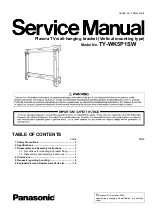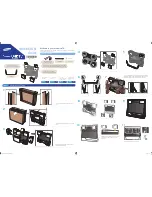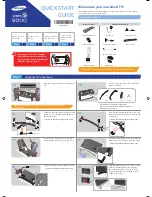
14
Electrical Instructions
A. ADJUSTMENT OF MAIN PLATE
1. Supply voltage: +100V.
Connect a voltmeter (DC) between the +2530 and mass. With
potentiometer 3518, adjust voltage to 101V5 for a 14” tube and 106V5
for a 20” or 21” tube.
2. Horizontal centring
Adjust with potentiometer 3354.
3. Picture height
Adjust with potentiometer 3410.
4. Focus adjustment
Adjust with the potentiometer placed on the line transformer.
5. APC
Connect a signal generator (e.g., PM 5326) as indicated in Fig. 1 and
adjust the frequency to 38.9 MHz. (PAL I: 39.5 MHz). Connect a volt-
meter to pin 44 of IC 7015:C and adjust voltage with 5040 to 3.5V
(DC).
6. AGC - RF
When the image of a powerful local TV station is distorted, adjust with
potentiometer 3021 until the problem is solved.
B. ADJUSTMENTS ON PICTURE TUBE PANEL
1. Tube cutoff (Voltage Vg 2)
Connect a picture white signal to the antenna.
Connect pin 25 of IC7015:E to mass.
Adjust the brightness until the DC voltage on potentiometer 3214 is
zero.
Using potentiometers 3234, 3207 and 3220, adjust the level of black
on the collector of transistors 7227, 7205 and 7218 to 125V for a 14”
or 21” tube, 130V for a 20” tube.
Adjust potentiometer Vg
2
until the light from the gun that comes on
first is barely visible.
Adjust the other two guns with the other controls (3234, 3207 or 3220)
until the light disappears.
2. Grey scale
Connect the test signal to the antenna and adjust TV controls as nor-
mal.
Let the TV warm up for at least 10 minutes. Adjust 3214 and 3213
until the desired grey scale is achieved.
PURITY AND CONVERGENCE ADJUSTMENT
NOTE:
The instructions for adjusting colour purity and convergence de
scribed below should be used only if the tube is replaced or when
full adjustment is necessary in any other cases. Even when the
deflection yoke is replaced, it is not necessary to move the rubber
wedges (“G” in Fig. 3). Small corrections can be made using the
multipole unit.
I. Colour purity. (Fig. 3)
1. Slightly loosen screw “F” (if CRT has a multipole unit).
2. Move the deflection coil and remove the three rubber wedges (“G”).
3. Slide the deflection coil as far as possible against the tube bulb and
tighten screw “F” so that the deflection coil can be moved with a
certain amount of resistance.
4. Position the multipole unit as shown in the diagram, tighten screw
“A” and turn safety ring “B” anticlockwise.
5. Place the TV facing either EAST or WEST and insert tube.
Connect a single crosshatch signal to the antenna and turn up the
brightness as high as possible. Let the TV warm up for 10 minutes.
6. Adjust the static convergence using tabs “C” and “D” (see Chapter
II if necessary).
7. Block the green and blue guns by disconnecting resistors 3216
and 3203, respectively.
8. Turn the colour purity rings with tab “E” so that the vertical red line
coincides as closely as possible with the centre of the screen and,
at the same time, make sure the centre horizontal line is as cor
rectly aligned as possible.
9. Connect a picture white signal and make sure the red vertical line
is in the centre of the screen. If it is not in the centre, connect the
crosshatch signal again and move the red vertical line in the right
direction, making sure that the image does not stray too far from
vertical.
10.Connect a picture white signal and move the deflection coil until
the inside of the screen is uniformly red.
11.Connect the green and blue guns and make sure that no spots
appear on the white screen obtained. If spots appear, they can be
corrected by turning rings “E” and/or moving the deflection coil.
12. Tighten screw “F”.
13. Now adjust the static and dynamic convergence.
II. Static convergence (Fig. 3).
(If CRT has a multipole unit)
1. Connect a crosshatch signal and let the TV warm up for 10
minutes.
2. Block the green gun by disconnecting 3216 and turning attachment
ring “B” anticlockwise.
3. Turn the 4-pole magnetic rings with tab “C” so that the blue and red
crosshatch pattern is superimposed in the centre of the screen.
4. Connect the green gun and disconnect the blue gun by disconnect
ing resistor 3203.
5. Turn the 6-pole magnetic rings with tab “D” so that the red and
green crosshatch pattern is superimposed in the centre of the
screen.
6. Connect the blue gun and set the multipole unit using ring ”B”.
III. Dynamic convergence
NOTE:
Dynamic convergence is obtained by moving the deflection coil hori
zontally and vertically. In order to ensure the exact position of the
deflection yoke, three rubber wedges are placed between the glass
of the tube bulb and the deflection coil as shown in Fig. 4a or 5d.
1. First adjust colour purity and static convergence.
2. Connect a crosshatch signal and disconnect the green gun by dis
connecting resistor 3216.
3. Eliminate the central, horizontal and vertical blue and red lines by
moving the deflection coil vertically. If the position of the deflection
coil is correct, place the rubber wedge (1) either straight up (Fig.
4a) or straight down (Fig. 5a).
The placement of the wedge as in Fig. 4a is correct if the deflection
coil is facing down.
4. By moving the deflection coil horizontally, the horizontal red and
blue line is superimposed in the top and bottom of the screen and
the red and blue vertical line to the left and right. If the position of
the deflection coil is correct, place wedges (2) and (3) as shown in
Fig. 4b or 5b. Firmly press the adhesive part of the wedge against
the tube glass.
5. Now place wedge (4) as in Fig. 4c or 5c and press so that it adheres
to the tube.
6. Remove wedge (1) and place it as shown in Fig. 4d or 5d.
7. Connect the green gun.
Summary of Contents for 1410R
Page 6: ...3 Overview oscillograms Testpoints ...
Page 12: ...9 Power supply signals ...
Page 15: ...12 Block diagram power supply 100 100 100 10V ...
Page 18: ...15 ...
Page 20: ...PCB LAYOUT ...
Page 21: ...PCB LAYOUT ...
Page 22: ...Bloc Bloc Bloc Bloc Block Dia k Dia k Dia k Dia k Diagram gram gram gram gram ...
Page 37: ...NOTES ...
Page 38: ...NOTES ...
Page 39: ...MATSUI 1410R 1410T 2010R ...
















































